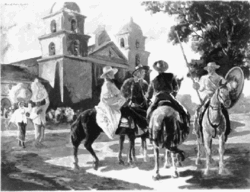Mission Santa Barbara
|
|
Known as "The Queen of the Missions," Mission Santa Bárbara in California was founded on December 4, 1786 by Father Fermín Francisco de Lasuén, who had taken over the Presidency of the California mission chain upon the death of Father Junípero Serra. It was the tenth mission founded, and was named for Saint Barbara.
The Mission sits on a rise overlooking both the City of Santa Barbara and the Pacific Ocean; the Santa Ynez Mountains rise almost 4,000 feet in back. During the first few years, there were three churches built, each larger than the previous one. It was only after the great 1812 earthquake, which destroyed the previous buildings, that the current Mission was begun. The towers again sustained considerable damage in a 1925 earthquake, but were subsequently rebuilt. The appearance of the inside of the church has not been altered since 1820.
Many elements of the Mission's extensive water treatment system, all built by Indian labor (including aqueducts, two reservoirs, and a filter house) remain to this day, as does a grain mill; the larger reservoir, which was built in 1806, has been incorporated into the city's water system. The original fountain and lavadero are also intact near the entrance to the Mission. A dam constructed in 1807 is situated in the current Santa Barbara Botanic Garden up "Mission Canyon." The Mission's tanning vats, pottery kiln, and guard house all lay in ruins to this day.
Mission Santa Bárbara is the only mission to remain under the leadership of the Franciscan Friars since the day of its founding until today. The Mission also has the oldest unbroken tradition of choral singing among the California Missions and, indeed, of any California institution. The weekly Catholic liturgy is serviced by two choirs, the California Mission Schola and the Cappella Barbara, both under the direction of composer Keith Paulson-Thorp. The Mission archives contain one of the richest collections of colonial Franciscan music manuscripts known today. These manuscripts remain closely guarded and most have not yet been subjected to scholarly analysis.
The original City of Santa Barbara developed between the Mission proper and the harbor, specifically near the Royal Spanish Presidio, about a mile southeast of the Mission. As the City grew, it extended throughout the coastal plain; a residential area now surrounds the Mission, although there are public parks and a few public buildings (such as the Natural History Museum) in the area immediately adjacent to the site.
The Mission Santa Bárbara today continues to serve the community as a parish church.
Historic designations
- National Register of Historic Places #NPS-66000237
- California Historic Landmark #309
See also
External links
- Official mission & parish website (http://www.sbmission.org/home.html)
- Elevation & Site Layout sketches of the Mission proper (http://www.mymission.org/images/santbarb.gif)
Santa_Barbara_circa_1910--William_Amos_Haines.jpg

